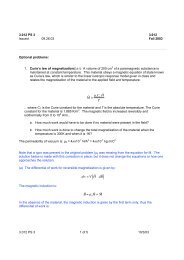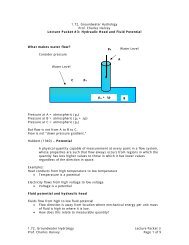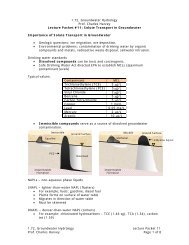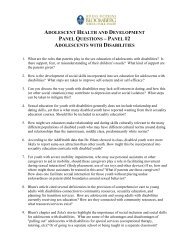Problem set 4: 24
Problem set 4: 24
Problem set 4: 24
Create successful ePaper yourself
Turn your PDF publications into a flip-book with our unique Google optimized e-Paper software.
<strong>Problem</strong> <strong>set</strong> 4: <strong>24</strong>.900<br />
Due Monday, March 11, 2001<br />
Name:_______________________________________________________<br />
Part 1: Igbirra (Nigeria) phonology<br />
Examine the distribution of [e] and [a] in the Igbirra data below, and answer the questions<br />
that follow:<br />
a. Are Igbirra [e] and [a] allophones of the same phoneme or distinct phonemes?<br />
b. Justify your answer by either stating a rule 1 that governs the distribution of [e] and [a]<br />
(if you think they are allophones of the same phoneme) or giving evidence that they are<br />
distinct phonemes 2 (if you think they are distinct phonemes).<br />
1<br />
"Stating a rule" means using the phonetic classification we have learned to describe<br />
which allophone is used in which<br />
environment (e.g. "before X", "after Y", "at the end of a word", etc.).<br />
2 Relevant evidence would be any minimal or near-minimal pairs present in the data.<br />
Otherwise, offer the best evidence you<br />
can that neither position in the word nor the segments preceding or following the sound<br />
in question are factors that determine their distribution.<br />
1
Part 2: Finnish phonology<br />
Examine the distribution of [d] and [t] in the Finnish data below, and answer the<br />
questions that follow:<br />
[madon] 'of a worm' [kade] 'envious'<br />
[kadot] 'failures' [maton] 'of a rug'<br />
[kate] 'cover' [ratas] 'wheel'<br />
[katot] 'roofs' [radan] 'of a track'<br />
Answer for Finnish [d] and [t] the same pair of questions you answered for Igbirra [e] and<br />
[a].<br />
Part 3: Various<br />
a. In CL, do problems 1, 2 and 4 (i)-(iv) on p. 121. [Do (v) for extra credit.]<br />
b. Russian Consider some pairs of forms from Russian. Call the forms in the left column<br />
"zero-ending forms" and the forms in the left column "-a forms", though the meaning and<br />
use of the two forms -a actually varies widely among the examples.<br />
zero-ending form -a form<br />
2
a. State the phonological rule affecting consonants that is illustrated by these forms.<br />
Make sure your statement of the rule covers all the data.<br />
b. How do we know that English lacks this rule?<br />
c. List the minimal pairs found in the Russian examples above. What does the existence<br />
of these minimal pairs teach us about the phonemic inventory of Russian?<br />
d. Assuming that phonologically predictable aspects of pronunciation do not form part of<br />
the lexical entries of morphemes, what are the forms listed in the lexicon for the root<br />
morpheme of the words in the first 6 rows above?<br />
3









